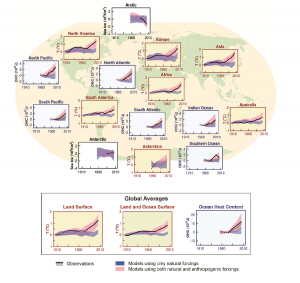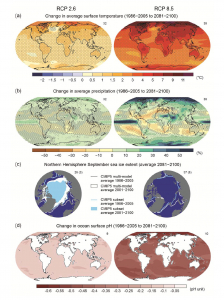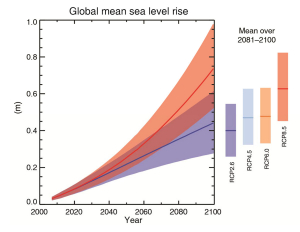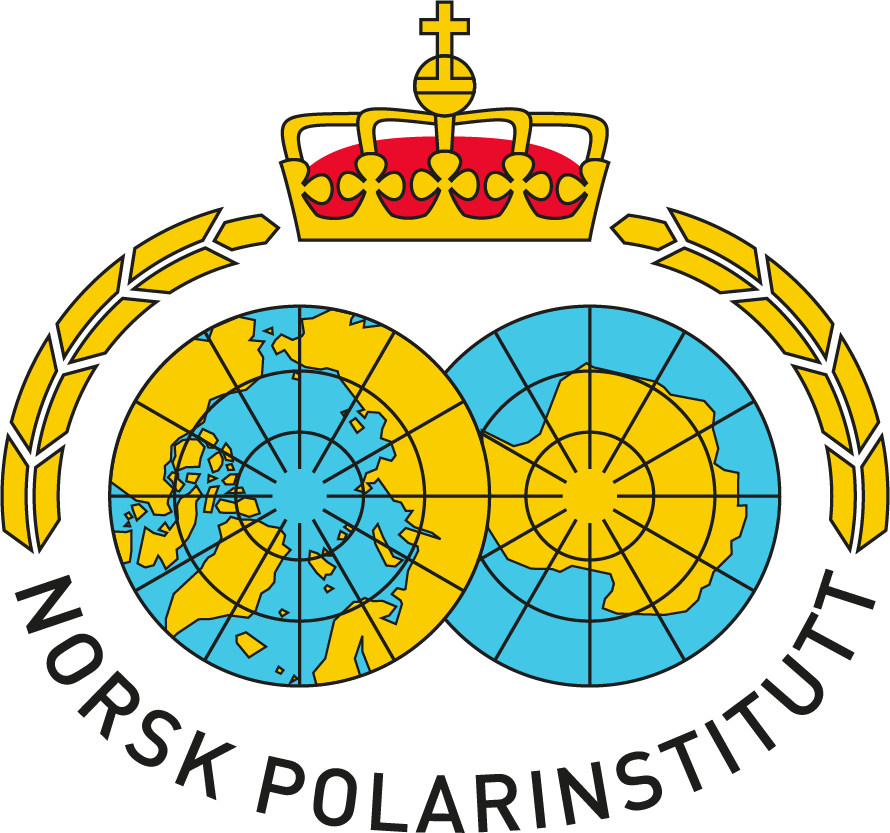Status

Figure: Working Group I Contribution to the IPCC Fifth Assessment Report
According to the most recent report from Working Group I of the United Nations’ Intergovernmental Panel on Climate Change (IPCC?) the average temperature on our planet has increased by 0.85°C in the past century, between 1880 and 2012, and the temperature has increased by 0.6°C since 1951. Each of the last three decades has been warmer than any past decade since 1850. In the northern hemisphere, the period between 1983 and 2012 was probably the warmest 30-year period in the past 1 400 years. This temperature increase is observed all over the world, but is largest in the northern hemisphere. The changes and trends in precipitation are less certain. Nonetheless, there is evidence showing that regions where extreme precipitation events have become more frequent outnumber those where they have become less frequent. Both North America and Europe have experienced more frequent or intense precipitation events.

Figure: Working Group I Contribution to the IPCC Fifth Assessment Report
Several long-term changes in climate have been observed, and they differ between continents, oceans and on a regional scale. Among these changes are higher temperatures and less ice in the Arctic, and alterations in total precipitation, sea salinity and wind patterns, occurrence of extreme weather such as drought, heavy rainfall, heat waves and intensified tropical cyclones.
IPCC is now quite certain that the net effect of human activity since 1750 has contributed towards this global warming, and that anthropogenic drivers have contributed between 0.5°C and 1.3°C of the increase seen from 1951 to 2010 (including the cooling effect of aerosols). Changes in extrinsic factors (sun cycle, volcanic activity, etc) and natural variability (slow responses of oceans and glaciers, for example) account for between ‑0.1°C and 0.1°C.
Future scenarios
All currently available climate models predict that warming will continue and accelerate. Future emission of greenhouse gases is a major factor determining how much the earth warms during the 21st century.
The most recent report from IPCC’s Working Group states that regardless of the representative concentration pathway (RCP)?) the global average temperature will increase by more than 1.5°C relative to the period 1850-1900, in the worst case by as much as 2.0°C. An increase of 0.3°C to 0.7°C is expected between the twenty-year periods 1986-2005 and 2016-2035. The models show that continued global warming is inevitable even after the end of this century. Most models show that warming in the Arctic will continue to be greater than in other areas. It is also estimated that extreme temperatures will be more common worldwide, and that heat waves are very likely to be more frequent and last longer.
Climate models
Climate models are highly advanced computer programs based on mathematical formulas describing the physical processes that influence the earth’s climate. These programs calculate what will characterise the climate of the future by combining the climate models with difference scenarios for emission of greenhouse gases
No climate model is perfect. Nonetheless, climate models have developed significantly in recent years, and continuous effort goes into further improvement, for example concerning regional differences and mechanisms in the climate system that are unique to polar areas.
Some parts of the climate system, such as clouds and particles in the atmosphere, remain exceedingly difficult to describe in mathematical formulas. Different models are constructed in different ways and include different components: they can yield somewhat different results. There is also uncertainty concerning future emissions of greenhouse gases and particles, which influences the certainty of the climate scenarios.
So far, climate models have not been able to project the rapid changes in the Arctic, although they have shown warming trends. The ice is melting faster that the models predict.
Representative concentration pathway
The Fifth Assessment Report from IPCC often refers to four concentration scenarios: Representative Concentration Pathways (RCPs). These scenarios are not assumptions about what the future holds. They describe which changes we can expect in the climate depending on the magnitude of greenhouse gas emissions the years to come.
The RCPs were selected to represent the entire spectrum of possible future emissions of greenhouse gases, and every one of these scenarios leads to an increase in temperature.
The climate in the Arctic has impact worldwide
Warming in the Arctic has consequences not only for climate developments and Arctic communities (both human and natural), but also throughout the world. First and foremost are the consequences for the climate system itself (and thus also for future climate). In addition, warming will affect sea level, which has a direct impact on people and societies in many parts of the planet.

Projections of global mean sea level rise over the 21st century relative to 1986–2005 from the combination of the CMIP5 ensemble with process-based models, for RCP2.6 and RCP8.5. The assessed likely range is shown as a shaded band. The assessed likely ranges for the mean over the period 2081–2100 for all RCP scenarios are given as coloured vertical bars, with the corresponding median value given as a horizontal line. For further technical details see the Technical Summary Supplementary Material (Table 13.5, Figures13.10 and 13.11; Figures TS.21 and TS.22). Photo: IPPC
The large-scale changes that take place in the arctic climate system exert a strong influence throughout the global climate system. The Arctic plays an important role in balancing the world’s climate. Changes here will therefore rapidly have repercussions in the rest of the world. For example, less sea ice leads to altered temperature and salinity in seawater, which in turn affect global ocean circulation patterns; these patterns play a major role in determining the climate in regions all over the world. Such alterations will also affect biodiversity far outside the Arctic. Inflow of fresh water from melting glaciers, ice caps and sea ice will also affect sea circulation and thus climate.
Deep water formation? and the thermohaline circulation? are important factors in maintaining temperature balance around the world, and they help keep Europe relatively warm. However, the stability of these processes is a topic of discussion. The increased amount of fresh water observed in the Arctic Ocean could theoretically perturb the thermohaline circulation and ultimately lead to cooling in regions around the North Atlantic. IPCC considers a collapse of the thermohaline circulation to be a ”low probability – high impact” risk associated with global warming. Most model simulations show that the thermohaline circulation is more likely to collapse than merely to weaken.
Weather and climate in the Arctic influence weather and climate in much of the rest of the world. The temperature difference between the cold Arctic and warmer regions in the south during autumn and winter drives the jet stream, which shapes and propels the weather systems of the northern hemisphere. But the temperature difference has decreased, and this affects the speed of the jet stream. One apparent result is that weather systems spend more time over certain regions, leading to extreme snowfall, drought, and heat waves. In addition, the warming of the Arctic allows the jet stream to meander more, bringing cold arctic air to farther south and allowing warm air to penetrate farther north, leading to new record high and low temperatures.
Many extreme weather events were recorded during the winters of 2009-2010 and 2010-2011; unusually high temperatures in the Arctic coincided with severe cold and heavy snowfall in China, the United States and Europe. Such extreme weather events arise owing to the random and unpredictable behaviour of weather systems and the causes are therefore difficult to trace.
Nonetheless, the recent major changes in the Arctic may have contributed to the extreme weather. Such changes in weather patterns will have far-reaching implications; for example, they may threaten global food production.
The effect of thawing permafrost on the carbon cycle is another crucial aspect for how climate evolves worldwide. Permafrost in the Arctic will thaw as a consequence of increasing temperatures in the soil, oceans, rivers and lakes that overlie the frozen ground. Carbon stored in the permafrost can then be released in the form of CO2 and methane, thus increasing the levels of greenhouse gases in the atmosphere and hastening global warming. But warming also affects the carbon content of the permafrost by making the active layer of the permafrost more productive: increased growth means increased carbon sequestration. The arctic permafrost is estimated to contain about 1.7 trillion tonnes of carbon – more than all human activity has generated since the beginning of the industrial revolution. A study in Canada estimated that thawing of the Canadian permafrost alone would release 75 to 560 million tonnes of carbon to the atmosphere before 2100, and increase the earth’s temperature by 0.5°C in addition to the warming that is already projected. However, estimates of the total amount of carbon that can be released from the permafrost remain highly uncertain, which limits the possibility of assessing the potential impact of such emissions. Empiric data and model simulations diverge considerably in terms of the amounts and locations of organic carbon in the permafrost regions, and a great deal of uncertainty remains concerning what role carbon in permafrost will play in the greenhouse gas balance.
The seabed also contains permafrost with huge stores of methane hydrates: the carbon content is estimated to 10 billion tonnes. Methane is twenty times more powerful as a greenhouse gas than CO2. It is still not clear how great a threat release of this carbon store would pose. Not enough is known about the time scale over which marine hydrates can become destabilised. The time scale is probably very long for hydrates in deep sediments, but shorter for hydrates in shallow seas such as the Arctic Ocean. Much uncertainty is related to lack of knowledge concerning the size and location of methane hydrate stores, how rapidly warmth penetrates through seawater and sediments, and the fate of methane in seawater.
Melting of glaciers and ice caps is expected to raise global sea level. Average sea level will continue to rise – and more quickly than in the period 1971-2010. Models show an increase of 0.52-0.98 metres before 2100, but these results depend on warming. So far, most of the rise in sea level has been caused by thermal expansion of seawater (a warmer ocean takes up more space); this effect is expected to continue to contribute 30-50% of the increase in years to come. Changes in the arctic cryosphere ? (ice on land) will underlie a substantial proportion of the expected increase.
Rising sea level has particularly dire implications for densely populated low-lying areas, including many island nations in the Pacific Ocean. More than a billion people – most of them in Asia – live in flat coastal areas. Within this century, some of these areas can be inundated by rising seas. The inhabitants will be forced to find solutions to the problem. Experts are hard at work trying to determine which regions will be hardest hit, but it is impossible to predict exactly how rising sea level will affect these coasts and island nations; so much depends on how great the changes are and how quickly they come about. Modern dynamic sea level models, which take into account storm winds and waves, paint a much more serious picture of the future for some of the low-lying islands in the Pacific than earlier models.
The climate in Antarctica has impact worldwide
The vast ice-bound expanses of Antarctica serve as a global thermostat, regulating the world’s climate system. The white ice cover cools the atmosphere through the albedo effect?, whereas the dark sea surface absorbs heat from the sun and plays a crucial role in the ocean’s heat budget. Cold surface water with high salinity plunges to the depths, driving the ocean currents that transport heat from one part of the earth to another. The Southern Ocean takes up carbon dioxide from the atmosphere, thus playing an important part in the carbon cycle.
Exchange of water between the Southern Ocean and the global bottom water circulation is a crucial piece in the climate puzzle. Altered water exchange affects global climate; such alterations can be brought about by changes in wind patterns around Antarctica and influenced by the Antarctic ice sheet.
The Southern Ocean is a major factor in the global carbon cycle because it links the physical climate system and the marine ecosystem. Atmospheric CO2 is taken up by the ocean, and over 40% of the total annual uptake of CO2 occurs here. However, model simulations and observations indicate changes over the past 50 years, and imply that total CO2 uptake has decreased in the past couple decades.
The Southern Ocean’s ability to take up CO2 can change as a result of warming in the ocean (warm water takes up less CO2), and as a consequence of altered circulation and interactions in the ocean–atmosphere–ice system. What role the Southern Ocean will play in the carbon cycle remains unclear, as does the effect of possible changes.
Water released when ice melts in Antarctica is absolutely central to assessments of the possible future rise in sea level. Glaciers – particularly those of the Antarctic Peninsula in West Antarctica – appear to be shrinking. Studies have revealed a strong correlation between temperatures in Antarctica and global sea level, which in turn correlates with global temperature over the past 520 000 years. Antarctica is expected to contribute to the rise in sea level projected over the next century. Loss of ice along the coast of Antarctica (calving and melting) is expected to exceed the increase in the mass of the inland ice sheet caused by greater precipitation; thus the overall effect is that Antarctica will continue to contribute to sea level rise. Collapse of those parts of the Antarctic ice cap that are in contact with the ocean – or where the bedrock is below sea level – would raise sea level considerably more than predicted, and in a very short time. Present knowledge shows, nonetheless, that such an event would raise sea level only a few decimetres during this century.
